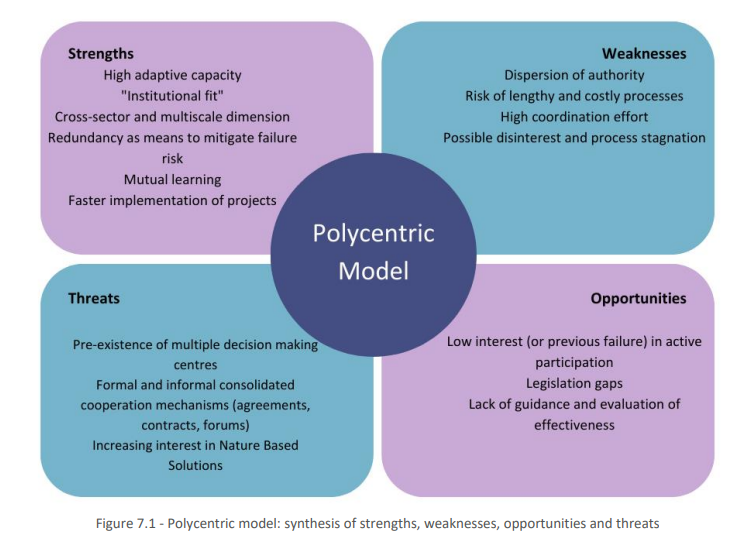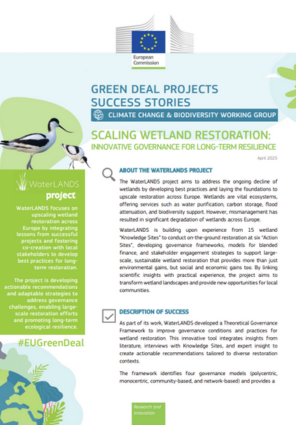About the project
The WaterLANDS project aims to address the ongoing decline of wetlands by developing best practices and laying the foundations for upscale restoration across Europe. Wetlands are vital ecosystems, offering services such as water purification, carbon storage, flood attenuation, and biodiversity support. However, mismanagement has resulted in significant degradation of wetlands across Europe. WaterLANDS is building upon experience from 15 wetland “Knowledge Sites” to conduct on-the-ground restoration at six “Action Sites”, developing governance frameworks, models for blended finance, and stakeholder engagement strategies to support large-scale, sustainable wetland restoration that provides more than just environmental gains, but social and economic gains too. By linking scientific insights with practical experience, the project aims to transform wetland landscapes and provide new opportunities for local communities.
Description of success
As part of its work, WaterLANDS aims to identify and develop suitable policy and governance frameworks that facilitate the success of large-scale inland and coastal wetlands ecological restoration. Under this, the project has developed the Theoretical Governance Framework for wetland restoration. It is a tool that identifies the governance conditions and measures necessary for successful restoration and provides recommendations for a wide range of users and contexts.
The tool was developed using insights from literature, interviews with those involved at WaterLANDS’ 15 Knowledge Sites (where wetland restoration has already been successfully demonstrated), and personal experience from the experts creating the tool.
The tool identifies four governance models (polycentric, monocentric, community-based, and network-based) and provides a SWOT (Strengths, Weaknesses, Opportunities and Threats) analysis for each, highlighting their strengths, weaknesses, and applicability. When applying the tool, projects may align with more than one governance model and have overlapping features. Key recommendations are made for each governance model which are organised under three pillars:
Co-creation and communication: Ensures continuous and effective participation from all stakeholders, from design to implementation.
Design and implementation: Establishes formal and informal governance practices tailored to restoration needs.
Sustainable legacy: Focuses on long-term governance practices and safeguards to ensure the durability of restoration efforts.

Figure 1: Example of a SWOT analysis for one of the governance models (polycentric)
Through its development, the tool identified critical factors for successful restoration, including multi-stakeholder collaboration, the importance of EU funding, and addressing fragmented land ownership. Conversely, it also highlighted common barriers such as insufficient funding, citizen scepticism, and lack of long-term strategies. To address these challenges, the tool provides a flexible "menu" of recommendations, actions, and examples of good practices, empowering stakeholders to adapt and respond to local governance needs effectively. The framework has been applied to identify governance challenges at the project’s six Action Sites (degraded sites where wetland restoration is being demonstrated in action), where tailored roadmaps are being developed to overcome barriers and implement sustainable governance practices.
Highlights
Developed the Theoretical Governance Framework, which identified four governance models and conducted a SWOT analysis with 25 recommendations, 50 actions, and 20 examples of good practices.
Interviewed stakeholders across 15 knowledge sites, addressing key barriers like funding gaps and fragmented ownership.
Provided actionable, adaptable tools to support large-scale wetland restoration and governance improvement.
Outputs
The Theoretical Governance Framework report, including methodology, has been published on the WaterLANDS website
Impact
The WaterLANDS’ theoretical governance framework has advanced the governance of wetland restoration, providing a flexible and actionable tool for addressing complex challenges. Through synthesising lessons from diverse knowledge sites and incorporating evidence-based practices, the framework has enabled stakeholders to design governance strategies that are tailored to their unique contexts.
Lessons
There is not a “one size fits all” governance model that can be directly replicated in every restoration site. Each model has its advantages and disadvantages and must be adapted to the specific context.
The adaptation and combination of models are essential for promoting appropriate governance, which will allow for effective ecological restoration and promote the potential for upscaling in the future.
It is essential to understand and manage stakeholder expectations and the power balances to close the gap between those who value and stand to benefit from the restored wetlands and those who have the authority to manage the restoration.

